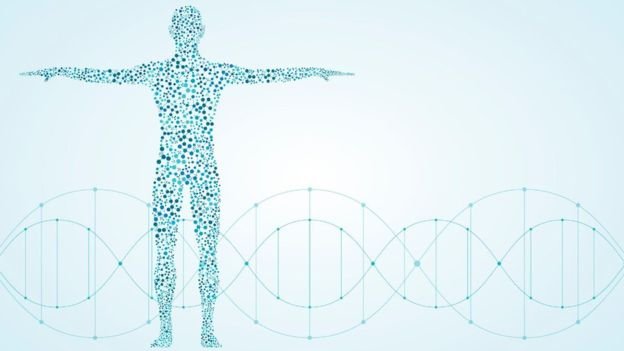A boy meets a girl, they fall in love and they have girls and / or children.
A well-known story at this point of humanity, but did you know that in nature there is a whole carnival of sexual practices that rethink the role of the sexes?
The BBC "detectives", the geneticist Adam Rutherford and the mathematician Hannah Fry, explore one of the mysteries of biology: why do we only have two genres?
To try to answer that question, they started with another question: what are the sexes for?
And they found that it does not always take two to have offspring.
Sexual autonomy
Some animals can reproduce without the need for a mate or mating, as is the case of the tiny creatures called Bdelloidea, a class of rotifers that live anywhere where there is water and that you can only see with a microscope.
There is also the case of Ganas, a Komodo dragon that lives in the London Zoo and has become one of its attractions.
"He has no father, his mother created him alone," explains Chris Michaels, herpetologist at the London Zoo. She conceived this large lizard spontaneously.
The process is known as parthenogenesis, literally: "virgin birth". It happens very rarely and only produces male offspring.
The komodos are among the few vertebrates that can get to reproduce through parthenogenesis,
A mathematical perspective
In the 1970s, sex became mathematical, says Fry.
The geneticist Aoife McLysaght, an expert in that field at Trinity College in Dublin, says that although many organisms have sex and reproduce, sex has been one of the enigmas of biology and evolution. Therefore, he says, "there must be a good explanation."
"In terms of evolution, the way to succeed is to pass your genes effectively to other generations and when we think about sexual reproduction, what we are doing is passing half of our genes to our children, who have half of the genes of someone else, we put a lot of effort into that and it seems inefficient, "says McLysaght.
Efficiency, inefficiency ... A whole evolutionary dilemma and two terms that Dr. Rutherford also introduces in this debate.
"The sexes are not very efficient, but they are everywhere and we are not sure why," says the geneticist.
But, he warns, there are clues in the asexual arsenal present in nature.
What a small organism teaches us
Chris Wilson, a researcher at Imperial College in England, is an expert on tiny creatures such as Bdelloidea.
"Because all (members) are equal, they have the same vulnerabilities, particularly with regard to diseases." Once an animal in your population is infected with a disease, such as a fungus, it will easily be transmitted to all of its daughters. , sisters and female relatives because they are all genetically alike, epidemics are unleashed very quickly that can affect all the rotifers, with that genetic combination, in a whole population. "
However, as Wilson explains, in nature there are tricks to prevent a disease from ending with a certain population and the rotifers know them: one of them is totally dehydrated.
And the 50 million (or more) years that have existed show that it has worked for them.
Most asexual creatures are relatively newer, dating back a few hundred thousand years, explains Rutherford.
And they do not last long. The reason? The diseases.
The advantages
This is how the biological benefits of the sexes become evident.

ISTOCK / GETTY IMAGES
Cloning yourself would imply that your clones are genetically identical to you.
If you could clone yourself, the resulting population will be genetically identical to you, says McLysaght.
"All the members are equally strong but also equally weak, whatever weakness one has, others will have."
"Something we know about how DNA changes is that each of us has about 60 mutations that are totally new and that have not been inherited from our parents (...) When we talk about sexual reproduction we talk about DNA combination of two different individuals, since it is not 100% of the DNA (of one of them), that means that there are probabilities of joining two good genes and even of generating an improvement with respect to the past and there are also probabilities of leaving the bad outside. "
This is how by joining our genes we become more resistant to parasites and diseases and increase the chances of improving genetics.
Why are there not three sexes?
In the animal world there are species that have parts of males and females in the same body: worms, snails, starfish and more than 20 families of small fish. It is about hermaphroditism, which allows male and female gametes to be produced.

ISTOCK / GETTY IMAGES
Our DNA has the contribution of our parents and also completely new mutations.
Fry points out that in the case of mushrooms, finding a partner can be very difficult. Therefore, "fungi have increased their sexes to increase their chances of successfully reproducing and spreading their genes."
But that in a very unique case, which leads to the question: And why do not we have more than two sexes?
Rutherford asked Wilson.
"The problem is that since there are already two sexes, it is very difficult for a third and new sex to appear and to do well, if we have a new intermediate sex, who are you going to mate with? Because you already have both males and females, each one has Specific adaptation mechanisms to maximize your success with the other If there is a third sex, it will be very difficult to find a partner, "said the researcher at Imperial College.
One of the reasons why humans and other complex animals have gravitated towards two sexes is the size of our gametes, the ovules (which are the largest cells in humans) and the sperm (which are the smallest cells), explains Rutherford.
And it is that the sperm and the ovum provide different biological imperatives for the males and the females: the spermatozoids are fast and small while the ovules are large and stable.
"They are like a padlock and a key, no additional pieces are required," says Rutherford.